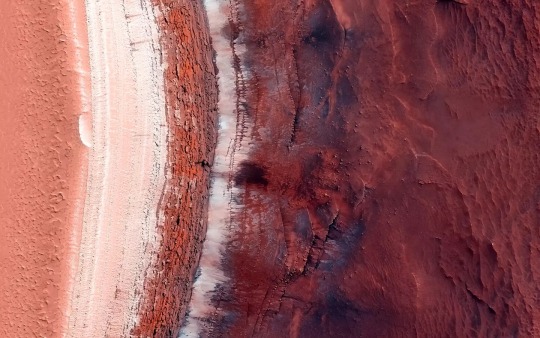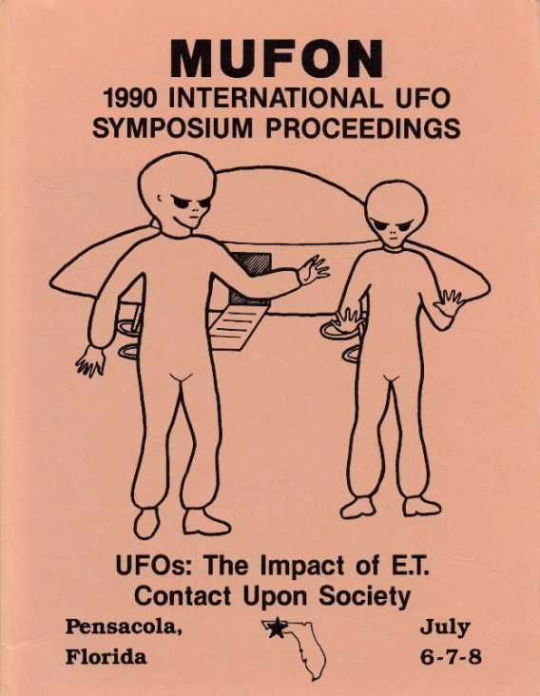#Alien life
Explore tagged Tumblr posts
Text




The climate in this region is usually hot and dry, punctuated by sporadic torrential downpours. After such events, the ground flourishes with a dense interconnected web of growth taking advantage of the temporary hydration. Once all the water dissipates, the soil is left to crack in the heat of the day. During these times Ponderosus are on the move, searching for the last remaining vernal pools. They used the times of plenty to fill up on nutrients, but now during a drought they switch primarily to photosynthesis to meet their energy needs. The smaller, dish-faced Lanx are not so lucky. Embedded in the ground unable to move, they must simply go dormant if the rains do not arrive soon enough. For now they point their open frills at the sun and gather energy while they still can. A Stealthspring prowls the scene looking for unfortunate small creatures who may not be faring well in the heat. Their predominant walking style requires a different gait for front and back sets of legs, but if needed their whole body becomes a giant spring, allowing them to burst forward for great distances. In an environment where major features like the ponderosus can move, it can be difficult to navigate from day to day, so the stealthspring must be ready to take flight at any time, should danger come calling.
#space#art#creature#alien#exobiology#drawing#astrobiology#creature design#speculative evolution#worldbuilding#specbio#alien life#digital art#scifiart#scifi#xenobiology
797 notes
·
View notes
Text

The artwork that helped get my first job in the videogame industry back in 2007.
It is a world I want to explore further...
956 notes
·
View notes
Text

Richard Hescox, "Fetch!," 1980's
545 notes
·
View notes
Text
Scientists believe they've found evidence of what was once an ocean on Mars. Check out the shoreline on mars!

#astronomy#nasa#astronomers#universe#nasa photos#astrophotography#outer space#astrophysics#nasawebb#hubble space telescope#mars planet#water on mars#life on mars#mars#ancient life#life in space#alien life#space exploration#space#science#james webb space telescope#planetary nebula#space science#nasa science#science facts#planetary science#cosmos#solar system#our universe#the universe
170 notes
·
View notes
Text

(Source)
#destiel#mars#alien life#nasa#science#ucsd#university of california#castiel#dean winchester#breaking news
379 notes
·
View notes
Text

Once again a creature from the continent of Slomen. A very primitive but also very specilised critter. 6 to 30 cm long, wet roots up to 45cm.
They live in many aquatic environments but most often you will find them in forest rivers and lakes. Some species have even adapted for life in the sea and could be considered fully aquatic while still air breathing.
Majority of the clade feeds on small animals like invertebrates sometimes parts of plants they can digest. Their hunting strategy is either burst swimming, jumping or just sliding on top of some slow prey.
There were two important species that started life on land, with the leaf ancestor being a smaller, less land specilised of the two. Leafs are one of their earliest evolutionary branches as land vertebrates and have retained many acient features like paw suckers and teeth instead of claws. In bigger vertebrates most of these little teeth were lost and became true claws or fingers (even present on the other land climber ancestor).
They can actually eat with their feet that are still closely connected to their stomach. But it applies only to very small food particles.
The wets are not very culturally significant but some regions do eat them. But the thick mantle isn't very tasty. In some places they symbolise good harvest season.
These little guys are also related to the 'birds' of Elve and I'm sure you can see why.
#art#speculative biology#artists on tumblr#digital art#artwork#worldbuilding#speculative evolution#spec bio#fantasy#original creature#creature design#spec evo#alien life#frog#slug#elve#pick up and run#speculative fantasy
729 notes
·
View notes
Text

✨ Predator and prey ✨
#oroginalart#speculative worldbuilding#artwork#art#original drawing#digital aritst#digital drawing#digital illustration#alien species#speculative design#speculative biology#alien life#my artwork#speculative zoology
60 notes
·
View notes
Text
Related to the convergence vs. contingency ask I got a while ago, here's a list of adaptations I'd expect to find on any planet with Earth-like surface conditions and complex (equivalent to Earth's post-Cambrian) life:
Cellular organization, eukaryote-like cells with separated compartments for genome and energy production; large organisms multicellular or at least multi-nucleate
Most energy in the biosphere ultimately from sunlight; most energy is produced in the shorter term by transferring electrons to a strong oxidiser, most likely oxygen
Sex-like recombination of genomes common; most large organisms have a unicellular stage in their lifecycle (e.g. a zygote) and reproduce sexually at least part of the time (and when they do, each individual has two genetic parents); some kind of sexual dimorphism is very common at any given time, at least at gamete level
Most biomass at any given time consists in photoautotrophs, i.e. organisms using sunlight to synthesize organic molecules from scratch; biomass on land is greater than biomass in water, unless land is rare or the colonization of land has not occurred a long time ago
Fractal structure and/or radial symmetry common among organisms that move little actively or not at all; phototrophs have leaf-like light collectors that overlap to form a dense canopy
Bilateral symmetry dominant among organisms that move actively (so, clear distinction between front and back, and between up and down, but not between left and right, especially in outer morphology); sense organs, mouth, and central nervous system concentrated at the front end
Multiple "tree-like" and "worm-like" clades; filter-feeding a very common strategy in water; everything that has to move fast in water is spindle-shaped
Nearly all mobile organisms have long-range chemical, mechanical, and electromagnetic senses (i.e. smell, hearing, and sight), with the respective organs arising independently many times; perception of electrical fields may be common in water but not in air; communication is overwhelmingly vocal and/or visual
Every large organism has some sort of skeletal support; a skeleton based on hydraulic pressure is common in small organisms that move slowly, and a jointed exoskeleton is probably common in small faster movers (hard shells built from carbonates or silica will be popular in water), but the vast majority of largest organisms (say, >1 kg) probably has an internal skeleton
86 notes
·
View notes
Text

#take me home#space#ufo#earth#alien#stars#sky#sightings#ufo sighting#aliens#extraterrestrial#flying saucer#nasa#outer space#paranormal#sighting#strangeness#unexplained#alien life#moon#et#uap
875 notes
·
View notes
Text

"All of that… didn’t matter?"
(Pls repost ;)
Hi, I’m currently working on my project called "Space is dead" and write the whole document about it
In short: Wery advanced aliens loose their sanity trying to find life on other planets, and end up going crazy realising what that space is dead OR something has killed all life here… what happened before and next? Well… stay and you’ll know
#spec bio#alien creature#illustration#creature#speculative biology#creature design#art#small artist#artist on tumblr#writing a story#original species#alien species#aliens#writing#original character#original story#speculative fiction#worlbuilding#speculative worldbuilding#alien#alien life
35 notes
·
View notes
Text

hoblo moment…



This is a perfectly preserved hoplopterygian. This specimen is believed to be a subadult, almost done with metamorphosis. This life stage is indicated by the shape and position of the eyes, the amount of segments and generally the proportions. This individual is believed to have died in brackish waters, as it was found in iron and copper based sedimentary rocks, and during the thalassian, copper was more oceanic while iron was more inland (lakes and rivers). This mix match of sediments suggest that freshwater hoplo pods were born in the ocean, staying planktonic until metamorphosis, where they will sink down and migrate inland towards lakes and rivers. The young hoplo is also preserved with a bunch of tiny holes on the body, believed to be the trichoderm’s namesake hairy skin. The preservation of this specimen also shows the transition between flat fin like limbs to the large spike like limbs that are used in defense.

This is a hoplo btw
Fan favorite in the Aline server
One of my favourites too
My guess is that the concept and how I made them let me more free with the speccing and creativity, they are so unique compared to everything else and they are so silly
absolute goobers

Also, paintig
#paleoart#speculative biology#speculative evolution#spec evo#art#clay#super silly#alien life#alien biology#mummification#I guess#perfectly preserved#idk#lore#Alien#aline 24 k#Aline#sculpture#painting#traditional art#:3#weird creature#sea creatures#creativity#hoplo moment#hoplopterygian
33 notes
·
View notes
Text


I have remastered and fixed up a lot of my earliest digital art for my soon-to-launch book Other Worlds: The Art of Alex Ries on Kickstarter.
Sign up here to know when we launch!
Bonus Lore:
Floater: A predatory being living among the endless skies of a gas giant, the three eyes looking down into the sea of atmosphere below. When prey is spotted, the gas bladder rapidly deflates and the creature free-falls, three lethal claws open as it descends...
Lantern-crest: Inhabiting lowland swamps, this being's unusual asymmetry was striking to exobiologists: one 'arm' holds aloft a compound eye, while the other skewers prey spotted in the murky fog. They communicate with one another via symbols projected on their bioluminescent head-crests.
232 notes
·
View notes
Photo

Horacio Salinas Blanch
1K notes
·
View notes
Text


#astronomy#nasa#astronomers#universe#nasa photos#astrophotography#outer space#astrophysics#nasawebb#hubble space telescope#galaxies#galaxy#life on venus#ancient life#mars planet#life in space#alien life#life on mars#astrography#astronomy facts#astronomy photography#i love astronomy#astronomy picture of the day#astrobiology#space travel#our universe#cosmos#the universe#international space station#space science
166 notes
·
View notes
Text
ODDYSEUS_MISSION_AE#1744
Sample obtained from the Odysseus mission, sent to gather information about the planet Kepler-138d, a super-earth water world characteristic for its dense, water saturated atmosphere, and whose clouds occasionally appear green.

The mystery of these green clouds has finally been resolved with this analysis of samples that were collected from one of these green clouds as the rover descended into the atmosphere, 15km up in the clouds.


A diverse community of cyanobacteria-like phototrophic microbes (described as Ambrosiasphaera sp.) seems to be responsible for the unusual color of the clouds. These microbes, alongside the many others in the floating ecosystem they help support, seem to have developed hydrogen filled membranous organelles to float over the dense atmosphere. They also seem to have developed a cell wall with an unusual microstructure, extremely water absorbing to take advantage of floating droplets of water.

Some species seem to have developed predatory lifestyles, feeding on the plentiful Ambrosiasphaera chains, here seen one of these lifestyles, here seen one with one of the most unusual ways observed to catch and consume prey (described as Flagellovenator sp.). It floats passively with its flagellum extended, until it comes into contact with something. The appendix is covered in hairs not unlike those on the feet of Gekkonids, able to stick without any sticky substance needed. Once captured, it's bivalves cell wall opens and an amoeboid body penetrates the cell wall and starts digesting it's prey.
#art#illustration#clip studio paint#speculative evolution#speculative biology#xenobiology#aliens#alien life#extraterrestrial#microscope#microorganisms
68 notes
·
View notes
